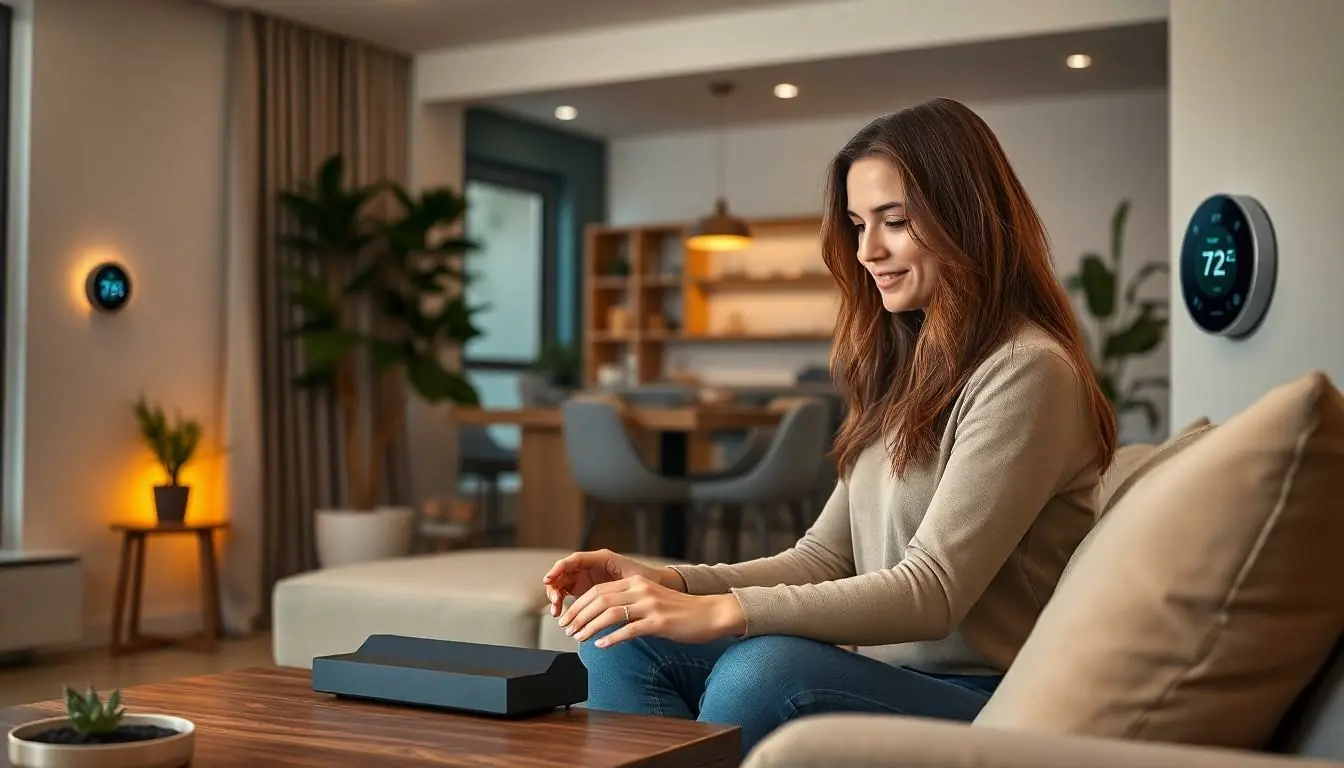Imagine walking into your home and having it greet you like an old friend. Smart home design isn’t just about gadgets; it’s about creating an experience that makes life easier, safer, and a bit more fun. From lighting that adjusts with your mood to coffee makers that know when you need that caffeine fix, these innovations transform everyday living into something extraordinary.
Table of Contents
ToggleOverview of Smart Home Design
Smart home design integrates technology seamlessly into daily living. It emphasizes user experience and environmental harmony. Innovations enhance functionality while promoting comfort and security.
Lighting systems adjust automatically to suit various moods or activities. For example, a smart thermostat optimizes energy use by learning schedules, saving both energy and costs. Smart appliances streamline tasks, such as a refrigerator that monitors food inventory and suggests recipes.
Safety is a priority in smart homes. Security cameras and doorbell systems provide real-time alerts and remote monitoring capabilities. Smart locks allow homeowners to control access from anywhere, offering peace of mind.
Home automation platforms centralize control of various devices. This integration fosters convenience while reducing the complexity of managing individual gadgets. Voice assistants enable hands-free operation for numerous functions, such as adjusting lighting or playing music.
Moreover, sustainability influences smart home design. Eco-friendly technology minimizes energy consumption and promotes responsible usage. Smart irrigation systems adjust watering schedules based on weather conditions, conserving water.
Additionally, personalized experiences cater to individual preferences. Users can program devices to respond to specific triggers, creating unique atmospheres throughout the day. These tailored setups improve quality of life in measurable ways.
Smart home design exemplifies a modern approach to living that embraces both technology and comfort. With its focus on user-oriented functionality, the concept transforms everyday spaces into responsive environments.
Key Features of Smart Home Design

Smart home design incorporates advanced features that enhance convenience, security, and comfort. Automation and integration play significant roles in this modern approach to living.
Automation and Control
Automation centralizes control over various home functions. Smart devices can operate on schedules or respond to triggers, streamlining routines. Homeowners benefit from programmable settings for lighting, temperature, and security systems. For instance, motion sensors can activate lights, while thermostats adjust based on preferences. These systems offer remote access through smartphones, enabling real-time updates and adjustments. Personalized automation creates an environment that adapts to individual lifestyles, promoting energy efficiency and ease of use.
Integration with Devices
Integration connects multiple smart devices into a cohesive system. Various technologies harmonize, ensuring seamless operation across platforms. Voice assistants play a crucial role, allowing users to control devices with simple commands. Integration facilitates compatibility among brands, enhancing flexibility in choosing smart products. For example, smart speakers can manage lighting, security cameras, and appliances from different manufacturers. This connectivity promotes an interconnected lifestyle, where devices communicate and operate in unison, creating a more synchronized home environment.
Benefits of Smart Home Design
Smart home design offers numerous advantages that elevate daily living experiences. These benefits extend beyond convenience to encompass energy efficiency and enhanced security.
Energy Efficiency
Smart home systems significantly reduce energy consumption. Devices like smart thermostats adjust heating and cooling based on occupancy, leading to notable savings on utility bills. Lighting systems adapt to available natural light, decreasing electricity use while maintaining brightness. Reports indicate that households with smart devices can lower energy expenditure by up to 30%. Monitoring tools track usage patterns, providing insights that help homeowners make informed choices. Increased automation leads to automatic power-off settings for appliances when not in use, further optimizing efficiency. Overall, smart homes leverage technology to create eco-friendly environments while saving money.
Enhanced Security
Security capabilities in smart homes contribute to peace of mind. Smart locks facilitate remote access and allow users to grant entry to visitors from anywhere. Real-time alerts from security cameras enable homeowners to monitor their properties, whether at home or away. It’s possible to create custom notifications for suspicious activity, maintaining vigilance at all times. Integration with alarm systems enhances protection, ensuring that various components work together seamlessly. Homeowners can also access footage or adjust settings through mobile apps, providing an added layer of convenience. Effective monitoring and control create a safer living environment, reinforcing the importance of smart home design in modern households.
Challenges in Smart Home Design
Smart home design faces several challenges that impact user experience and functionality.
Privacy Concerns
Data security poses significant risks in smart home environments. Smart devices often collect user information, which can lead to unauthorized access if not properly managed. Hackers can exploit vulnerabilities in connected systems, compromising personal data. Users frequently express concerns about surveillance, fearing eavesdropping from devices like smart speakers and cameras. Protecting privacy requires robust encryption methods and secure software updates to counteract threats. Homeowners must stay educated on privacy settings to minimize risks associated with smart technology.
Technical Complexities
Technical issues frequently arise in smart home systems. Integrating various devices from multiple manufacturers can lead to compatibility challenges. Users encounter problems when trying to connect devices that operate on different communication protocols, creating confusion. Troubleshooting issues often requires expertise that not every homeowner possesses. Additionally, software updates can disrupt device functionality if not properly coordinated. Ensuring a seamless experience means investing in reliable platforms that support a wide range of devices while simplifying user interfaces. Addressing these complexities is crucial for maximizing the benefits of smart home technology.
Future Trends in Smart Home Design
Innovative technologies shape the future of smart home design. Homeowners prioritize integration with artificial intelligence, making devices smarter and more intuitive. Increased personalization allows systems to adapt to individual lifestyles, adjusting settings based on preferences. Enhanced voice control capabilities simplify operation, offering seamless interactions between users and devices.
Sustainability stands at the forefront of smart home trends. Energy-efficient devices, such as solar-powered appliances, gain popularity, significantly reducing carbon footprints. Smart energy management systems help users track and optimize energy consumption in real-time. Reports show these systems can decrease utility bills by an average of 20%, proving beneficial for both households and the environment.
Safety continues to evolve alongside technological advancements. Enhanced security measures, including facial recognition and comprehensive monitoring systems, bolster peace of mind. Recent studies indicate that homes equipped with smart security features experience up to 50% fewer break-ins, highlighting their effectiveness in crime prevention.
Interoperability drives collaboration among manufacturers, leading to standardized protocols. Standardized systems facilitate smoother communication between devices, boosting the overall user experience. This trend reduces frustration associated with incompatible devices, ensuring users enjoy cohesive functionality across their smart home environments.
Augmented reality and virtual reality are emerging technologies impacting smart home design. Homeowners can visualize home automation setups before implementation, aiding decision-making and enhancing satisfaction. Gamified interfaces engage users, making routine tasks more enjoyable through interactive experiences.
Ultimately, the future of smart home design focuses on pushing boundaries, enhancing user experiences, and promoting energy efficiency. Advanced technology interweaves with daily living, transforming homes into intelligent, responsive spaces that cater to individual needs while ensuring safety and sustainability.
Smart home design is shaping the future of living by merging technology with everyday comforts. By prioritizing user experience and environmental sustainability, it transforms ordinary spaces into intelligent environments. Homeowners are now able to enjoy enhanced security and energy efficiency while personalizing their living spaces to fit their lifestyles.
As innovations continue to evolve, the integration of artificial intelligence and advanced safety measures will further optimize these designs. Embracing smart home technology not only promotes convenience but also fosters a deeper connection between individuals and their living spaces. With ongoing advancements, the potential for smart homes to enrich daily life remains limitless.



